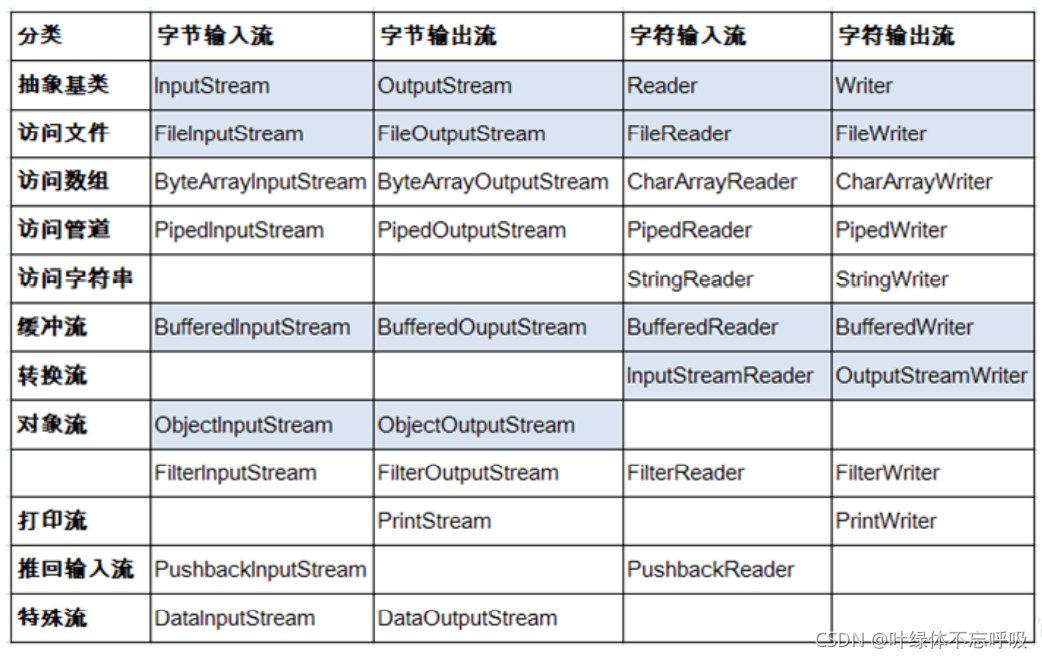Java IO流之原理分類與節點流文件操作詳解
IO流簡介
I/O是Input/Output的縮寫, I/O技術是非常實用的技術,用於處理設備之間的數據傳輸。如讀/寫文件,網絡通訊等。
Java程序中,對於數據的輸入/輸出操作以“流(stream)” 的方式進行。
java.io包下提供瞭各種“流”類和接口,用以獲取不同種類的數據,並通過標準的方法輸入或輸出數據。
IO流原理
輸入input:讀取外部數據(磁盤、光盤等存儲設備的數據)到程序(內存)中。
輸出output:將程序(內存)數據輸出到磁盤、光盤等存儲設備中。

流的分類
①按操作數據單位不同分為:字節流(8 bit 一般用於非文本文件),字符流(16 bit 一般用於文本文件)
②按數據流的流向不同分為:輸入流,輸出流(相對的)
③按流的角色的不同分為:節點流(直接處理文件),處理流(處理被包含的流)

IO 流體系
Java的IO流共涉及40多個類,實際上非常規則,都是從如下4個抽象基類派生的。
由這四個類派生出來的子類名稱都是以其父類名作為子類名後綴。


節點流和處理流
節點流:直接從數據源或目的地讀寫數據

處理流:不直接連接到數據源或目的地,而是“連接”在已存在的流(節點流或處理流)之上,通過對數據的處理為程序提供更為強大的讀寫功能。

節點流操作
讀入以FileReader為例
import java.io.File;
import java.io.FileReader;
import java.io.IOException;
/**
* @Author: Yeman
* @Date: 2021-09-25-16:30
* @Description:
*/
public class FileReaderTest {
public static void main(String[] args) {
FileReader fileReader = null;
try { //一定需要try-catch
//1、實例化File對象,指明要操作的文件
File file = new File("IO\\hello.txt");
//2、提供具體的流
fileReader = new FileReader(file);
//3、讀取操作
int read = fileReader.read(); //空參為一位一位讀取,末尾返回-1
while (read != -1){
System.out.print((char) read);
read = fileReader.read();
}
} catch (IOException e) {
e.printStackTrace();
} finally {
//4、關閉流
try {
if (fileReader != null) { //確保不會因具體流未創建而產生空指針異常
fileReader.close();
}
} catch (IOException e) {
e.printStackTrace();
}
}
}
}

import java.io.File;
import java.io.FileReader;
import java.io.IOException;
/**
* @Author: Yeman
* @Date: 2021-09-25-16:30
* @Description:
*/
public class FileReaderTest {
public static void main(String[] args) {
FileReader fileReader = null;
try { //一定需要try-catch
//1、實例化File對象,指明要操作的文件
File file = new File("IO\\hello.txt");
//2、提供具體的流
fileReader = new FileReader(file);
//3、讀取操作
char[] chars = new char[5];
//char型數組為參數,該數組相當於一個容器,把讀取放在裡面,返回該次讀取的個數,末尾返回-1
// 最後若不夠,容器後部分仍為上一次取的,前部分則被新的這次取到的覆蓋瞭
int length = fileReader.read(chars);
while (length != -1){
for (int i = 0; i < length; i++) {
System.out.print(chars[i]);
}
length = fileReader.read(chars);
}
} catch (IOException e) {
e.printStackTrace();
} finally {
//4、關閉流
try {
if (fileReader != null) {
fileReader.close();
}
} catch (IOException e) {
e.printStackTrace();
}
}
}
}
寫出以FileWriter為例
import java.io.*;
/**
* @Author: Yeman
* @Date: 2021-09-25-16:30
* @Description:
*/
public class FileReaderTest {
public static void main(String[] args) {
FileWriter fw1 = null; //若硬盤中不存在file,創建之;若存在,內容覆蓋之
try {
//1、實例化File對象,指明要寫出的文件
File file = new File("IO\\hi.txt");
//2、創建具體的流
fw1 = new FileWriter(file);
//FileWriter fw2 = new FileWriter(file,false); //若硬盤中不存在file,創建之;若存在,內容覆蓋之
//FileWriter fw3 = new FileWriter(file,true); //若硬盤中不存在file,創建之;若存在,內容追加之
//3、寫出操作
fw1.write("Hello World!\n",0,5); //寫出“Hello”
fw1.write("你好,世界!"); //寫出“你好,世界!”
} catch (IOException e) {
e.printStackTrace();
} finally {
//4、關閉流
try {
if (fw1 != null) fw1.close();
} catch (IOException e) {
e.printStackTrace();
}
}
}
}
實現一個圖片復制(讀入寫出,使用字節流)
import java.io.*;
/**
* @Author: Yeman
* @Date: 2021-09-25-16:30
* @Description:
*/
public class FileReaderTest {
public static void main(String[] args) {
FileInputStream fis = null;
FileOutputStream fos = null;
try {
File inFile = new File("IO\\input.jpg");
File outFile = new File("IO\\output.jpg");
fis = new FileInputStream(inFile);
fos = new FileOutputStream(outFile);
byte[] bytes = new byte[1024]; //通常使用1024,2的10次方
int length = fis.read(bytes);
while (length != -1){
fos.write(bytes,0,length);
length = fis.read(bytes);
}
} catch (IOException e) {
e.printStackTrace();
} finally {
try {
if (fos != null) fos.close();
} catch (IOException e) {
e.printStackTrace();
}
try {
if (fis != null) fis.close();
} catch (IOException e) {
e.printStackTrace();
}
}
}
}
到此這篇關於Java IO流之原理分類與節點流文件操作詳解的文章就介紹到這瞭,更多相關Java IO流內容請搜索WalkonNet以前的文章或繼續瀏覽下面的相關文章希望大傢以後多多支持WalkonNet!